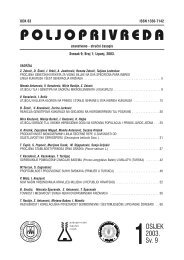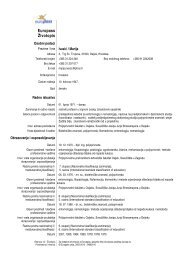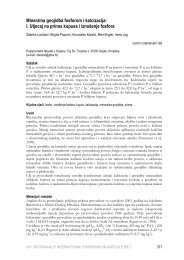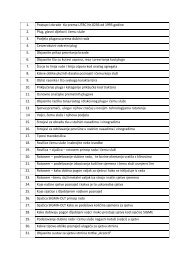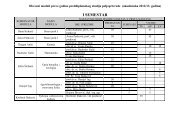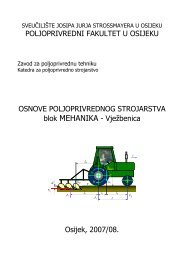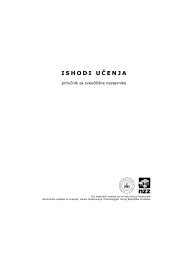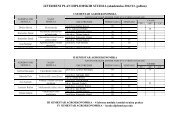Poljoprivreda 2-2006 final.qxd
Poljoprivreda 2-2006 final.qxd
Poljoprivreda 2-2006 final.qxd
Create successful ePaper yourself
Turn your PDF publications into a flip-book with our unique Google optimized e-Paper software.
60<br />
Z. Tolušić et al.: GAME MEAT MARKET IN EASTERN CROATIA<br />
Table 1. Data on hunted game in the Republic of Croatia, 1993-2002<br />
Tablica 1. Podaci o broju odstrijeljene divljači u Republici Hrvatskoj od 1993.-2002. godine<br />
Source: Statistical Yearbook, 2003; Izvor: Statistički ljetopis, 2003.<br />
grounds, which can be interpreted as a proof of their<br />
sustainable management. The most game animals were<br />
killed in their natural environment, in a finishing phase of<br />
rearing on a hunting ground. Number of killed-off pheasants<br />
was increased by 5%, roe deers by 21% and deers<br />
by 57%. The highest increase of 176% was noticed in<br />
number of killed-off wild boars. Killing-off of other game<br />
was marked by either stagnation or lowering. These official<br />
statistical records are indicative and reflect a trend<br />
of killing-off game, but not the exact state, because<br />
registers of hunting organizations are more or less questionable,<br />
mostly because of lack of knowledge of<br />
responsible individuals, and because of non existence of<br />
standardized work procedure in keeping hunting<br />
records. However, this problem is not obvious only in<br />
Croatia. Lecocq (1997) claimed that trading procedure<br />
for game meat in the European Union member states<br />
was not completely transparent, because statistics is<br />
often incomplete, thus making correct evaluation of data<br />
almost impossible.<br />
Based on the results of the survey carried out<br />
among inhabitants of Eastern Croatia, the majority of<br />
people involved in the survey (92%) did consume game<br />
meat (Figure 2). Men consumed game meat more often,<br />
thus being able to distinguish better among its varieties,<br />
which is in accordance with the research of Burger<br />
(2000). The fact that game meat is healthier and of better<br />
quality, i.e. that it has particular nutritive advantages<br />
over domesticated meat, is recognized by 66% of examinees.<br />
Mann (2000) stated that it was scientifically<br />
proven that consumption of such meat does not impose<br />
any risks for diseases occurrence of so called “western<br />
way of living”, such as coronary heart diseases. Human<br />
health is endangered by overconsuming fats and domesticated<br />
meat rich in saturated fat. On the other hand,<br />
consumption of diets high in lean red meat can lower<br />
cholesterol in blood plasma, provide tissue with omega<br />
3 fatty acids and represent a valuable source of iron,<br />
zinc and vitamin B12. Game meat fits to all of these, as<br />
it is low in total and saturated fat, but it is relatively poor<br />
in polyunsaturated fatty acids (PUFA). Such meat is a<br />
healthy component of any well-balanced nutrition.<br />
According to the research results, 87% of examinees<br />
consider game meat as ecologically healthy food.<br />
This is supported by researches of Lusky et al. (1994),<br />
who confirmed that game meat was not polluted by<br />
environmental contaminants (heavy metals, pesticides,<br />
radioactive elements, etc.). Furthermore, Haldimann et<br />
Figure 2. Consumption of game meat<br />
Grafikon 2. Konzumacija mesa od divljači<br />
POLJOPRIVREDA 12:<strong>2006</strong> (2) 58-63



